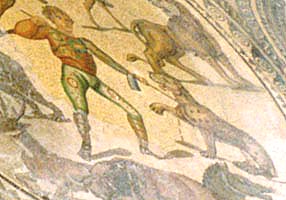In the book of the Roman historian Suetonius "The Lives of the Emperors" there is a reference to the vision of the emperor Domitinius
Haim Mazar

In the book of the Roman historian Suetonius "The Lives of the Emperors" there is a reference to the vision of the emperor Domitinius (AD 57-96). "His vision was somewhat short...Keli Zein didn't like anything. On the other hand, he showed great affection for the bow. When they were secluded in Albanum, he frequently felled various kinds of animals by the hundreds in front of many and deliberately shot at the heads of some of the animals so that two arrows pierced their heads with two horns. At times he would place some boy in the distance, who would raise his outstretched right palm as a shooting target, and Domitinus shot the arrows with such great skill that they all passed between the fingers of the hand without damaging them" (Suetonius 1940: 99-100).
The historian refers to two things, close vision and distant vision with the emperor. Regarding the close-up view, the description is short and precise in its definition. Regarding remote vision, the description is detailed but without definition. What this implies is that Svantonius knew how to distinguish between nearsightedness and farsightedness. In the case of Domitinus, Caesar had a limitation, albeit a slight one, regarding objects seen up close and an impressive ability regarding distant vision.
In the description of Domitinus' myopia there is a reference to its strength without any quantitative assessment, knowledge that did not exist at that time. From Swantonius's description, it can be understood that the Romans knew how to distinguish between mild myopia and severe myopia to the point of functional impairment, although elsewhere there is a reference to this. It is said about one of the Roman dignitaries in 100 BC that he resigned from his position due to his complaint that he could not read due to his advanced age and that he had to use the help of his slaves to read the scriptures to him (DREWRY:web). On the other hand, if we go back to Greece, it is known that Plato wrote until the end of his life and that he was 80 years old when he died. Which implies that despite his advanced age, his eyesight was good and he had no difficulty either reading or writing.
In Roman society, those who were supposed to use good close vision were literate and those who engaged in delicate manual work. Distant vision was essential for warriors, especially archers, bayonet throwers and army commanders who had to see large parts of the battlefield if they stood on a high place to observe what was happening. Those who had difficulty seeing in the distance could not be used either as archers or as javelin throwers. It is likely that the Roman army had records of those who had difficulty seeing in the distance so that they could be assigned to other positions. These records probably also existed in the public service regarding the short sighted since they would have difficulty reading and could no longer be used in their role. A question that could ask how those who had to retire from these positions would feel. This was a violation of their intellectual property and ability.
Sources
Swentonius Caius Tranquillus - The Lives of the Emperors, House of Flavius, Warsaw Publishing House, 1940, 104 p.
